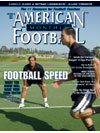AMERICAN FOOTBALL MONTHLY THE #1 RESOURCE FOR FOOTBALL COACHES
Article CategoriesAFM Magazine
|
Speed Report: Specific Speed Techniques and Drills for Outside Linebackersby: Dale BaskettFootball Speed Specialist © More from this issue Outside linebackers move through many types of speed changes. Sound mechanical control is vital if they are to be successful at each movement phase conducted. The thrust of this article will be directed towards sharing nuggets for outside linebackers. As indicated in the October issue on ‘Increasing Your Linebacker Speed’ once mechanical effectiveness is attained then we can move on to position specific movement applications. This month I will focus on specific movement aspects for some of the more basic assignments required for outside linebackers. The Most Critical Movement: The First Step All movement whether linear, lateral, short, long, etc., must develop from the first position step taken. The first step needs to be in proper relation to the center of body mass. This establishes the foundation for the ....The full article can only be seen by subscribers. Subscribe today!
|
|
|||||||
| HOME |
MAGAZINE |
SUBSCRIBE | ONLINE COLUMNISTS | COACHING VIDEOS |
Copyright 2025, AmericanFootballMonthly.com
All Rights Reserved





